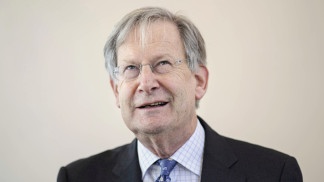Sir John Eliot Gardiner with the Symphonieorchester des Bayerischen Rundfunks at the notorious Gasteig in Munich last week. Gardiner isn't getting any younger, but he's greatly loved. Every opportunity to hear him live is worth cherishing. This time he conducted Emmanuel Chabrier and Claude Debussy. A delightful programme, elegantly constructed. Playful, even, sparked with Gardiner's characteristic wit. Setting the scene, the concert began with Chabrier's Overture to Gewendoline, (1886), much better known than the opera itself. Gwendoline is a fantasy on early medieval Britain, set in an Anglo-Saxon village being raided by Danes. The opera wasn't a huge success, neither comic nor grand enough for Parisian taste, yet not over the top enough for Wagnerian audiences. Nonetheless, it probably deserves revival these days, when the ideal of unified Europe is under threat. Much better Chabrier's civilized if slightly dotty romance than the rumblings of nationalist extremism. Perhaps in those sweeping strings, we can imagine the swelling waves of the North Sea, and winds blowing the Vikings ashore. Mock medievalism in glory: neither mayhem nor pillage on the horion.The winds suggest Tristan und Isolde, and the finale explodes, trumpets and trombones ablaze, and giant crashing percussion. True MGM richness!
Rather more elegant, Chabrier's Suite Pastorale (1888) orchestrating four of the composer's 10 Pièces pittoresques (1881) Gardiner's lightness of touch was ideal : these pieces charm because they're light and aphoristic. Then the Fête polonaise from Chabrier's opera Le roi malgré lui. (1887). It's not kitsch "Polish", though the last movement is part waltz and part polka, almost a parody of Vienna and the Johann Strausses. But it's echt Chabrier. Gardiner and the BRSO executed the piece stylishly, the scherzo-valse executed with vivacious flair. Last year, Chabrier's L'étoile was staged at the Royal Opera House. Chabrier's idiom doesn't fit into neat operatic categories. Its warm hearted, unpretentious cheerfulness expresses itself in a taste for absurd whimsy. The key to understanding L'étoile was, I think, understanding his orchestral music, and his ironic style. So if the opera didn't go down well with London audiences that says as much about them as it does about Chabrier. Thus, Chabrier's "greatest hit" España (1883). A delicious performance, like a tourist's memory of an ideal holiday in Spain. The strings whirr like strumming "guitars" and flamenco rhythms add spice. And, like a tourist fantasy, it doesn't last. In this case, six minutes!
Chabrier's "travelogues" complemented Debussy's Images, in the sense that the most famous section, Ibérica, has a Spanish context. Gardiner began, though, with the Rondes du Printemps. Rounds: hence the cyclic feel of the piece, reminiscent of the "waves" in La Mer, written at roughly the same period, the folk melodies flowing like undertow. Gardiner followed this with Gigues to reinforce the idea of abstract form as opposed to pictorial colour. True, Ibérica incorporates features that might evoke Spanish flavour, but it is also a "round" in itself, being made up of three inner sections, the outer two inspired by abstract form.The core, Les parfums de la Nuit is mysterious. Its beauty needs no ostensible title. Listen to the rebroadcast of this concert here on BR Klassik.
Rather more elegant, Chabrier's Suite Pastorale (1888) orchestrating four of the composer's 10 Pièces pittoresques (1881) Gardiner's lightness of touch was ideal : these pieces charm because they're light and aphoristic. Then the Fête polonaise from Chabrier's opera Le roi malgré lui. (1887). It's not kitsch "Polish", though the last movement is part waltz and part polka, almost a parody of Vienna and the Johann Strausses. But it's echt Chabrier. Gardiner and the BRSO executed the piece stylishly, the scherzo-valse executed with vivacious flair. Last year, Chabrier's L'étoile was staged at the Royal Opera House. Chabrier's idiom doesn't fit into neat operatic categories. Its warm hearted, unpretentious cheerfulness expresses itself in a taste for absurd whimsy. The key to understanding L'étoile was, I think, understanding his orchestral music, and his ironic style. So if the opera didn't go down well with London audiences that says as much about them as it does about Chabrier. Thus, Chabrier's "greatest hit" España (1883). A delicious performance, like a tourist's memory of an ideal holiday in Spain. The strings whirr like strumming "guitars" and flamenco rhythms add spice. And, like a tourist fantasy, it doesn't last. In this case, six minutes!
Chabrier's "travelogues" complemented Debussy's Images, in the sense that the most famous section, Ibérica, has a Spanish context. Gardiner began, though, with the Rondes du Printemps. Rounds: hence the cyclic feel of the piece, reminiscent of the "waves" in La Mer, written at roughly the same period, the folk melodies flowing like undertow. Gardiner followed this with Gigues to reinforce the idea of abstract form as opposed to pictorial colour. True, Ibérica incorporates features that might evoke Spanish flavour, but it is also a "round" in itself, being made up of three inner sections, the outer two inspired by abstract form.The core, Les parfums de la Nuit is mysterious. Its beauty needs no ostensible title. Listen to the rebroadcast of this concert here on BR Klassik.

No comments:
Post a Comment